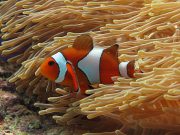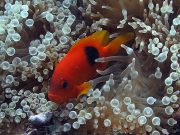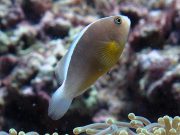Dykning med Klovnefisk
Koh Lantas Marineliv | Amphiprioninae
Klovnefisk eller anemonfisk er søsterfamilien til damselfisk og kan let ses på dykkerture på Koh Lanta. Med voksne fisk, der når en størrelse på 15 cm, er dette en familie af små fisk, der udviser et meget usædvanligt partnerskab med nogle havanemoner.
Klovnefisk har udviklet en mutation i slimhinden, der gør det muligt for dem at leve blandt havanemonernes brændende tentakler. Klovnefisk eller anemonfisk er beskyttet mod rovdyr, der ikke kan tåle anemonernes brændende tentakler. Til gengæld forsvarer klovnefiskene anemonerne mod parasitter og andre fisk, der kan jage dem, såsom sommerfuglefisk.
Klovnefisk lever hovedsageligt af små plankton, og en lille del af deres kost kommer fra alger og ufordøjet mad fra deres værtsanemone. Til gengæld giver klovnefiskens afføring næringsstoffer til værtsanemonen. Klovnefiskens konstante bevægelse af finnerne hjælper med at sikre vandcirkulationen og ilte værtsanemonens tentakler, især om natten, hvor der ikke foregår fotosyntese.
I en gruppe klovnefisk, der lever i en anemone, er den største en hun, og alle de andre er hanner. Den næststørste kolonimedlem er den dominerende han, der parrer sig med den kvindelige 'leder'. Alle andre mindre hanner bremser aktivt deres vækst for at forblive underordnede og dermed ikke udgøre en trussel mod den dominerende han (i tilfælde af at de bliver smidt ud af anemonen). Der eksisterer en klar hierarki, hvor hvert efterfølgende hanmedlem af kolonien er mindre end det ovenstående. Nogle kolonier kan bestå af 5, 6 eller flere medlemmer. Hunnen vil forsvare anemonen mod invasion.
Hvis den kvindelige klovnefisk forlader kolonien eller dør, vil den dominerende han gennemgå en periode med hurtig vækst og skifte køn for at erstatte den tidligere dominerende kvindelige koloni-leder. Den næstlaveste han i kolonihierarkiet vil derefter også vokse hurtigt i størrelse for at blive den dominerende han og danne et nyt par. Denne proces med hurtig og kontrolleret vækst gentages for alle unge hanner, så deres rangorden inden for kolonien bevares.
4 arter fundet på denne side:
Clark's Anemonefish
(Amphiprion clarkii)

Amphiprion clarkii @ Koh Haa
The Clarks Anemonefish, or Yellow-tail Anemonefish has a variable body colour, ranging from black to entirely orange. The body colour is determined by the host anemone, There are a pair of wide white or pale bluish bars on the body. The tail fin is yellow, possibly with a white tail fin base, and usually with an abrupt boundary if the body colour is black. The other fins are variably black to yellow-orange. The orange body variation may have a dark blotch behind the second white bar.
Males of this species may grow to 10 cm, and females to 15 cm, but often observed smaller than this. Sex reversal is completed in 5-6 months. Clarks Anemonefish can be found with the anemones Cryptodendrum adhaesivum, Entacmaea quadricolor, Heteractis aurora, Heteractis crispa, Heteractis magnifica, Heteractis malu, Macrodactyla doreensis, Stichodactyla gigantea, Stichodactyla haddoni, and Stichodactyla mertensii.
False Clown Anemonefish
(Amphiprion ocellaris)

Amphiprion ocellaris @ Koh Haa
The False Clown Anemonefish ranges from orange to reddish-brown and has 3 white bars on the body. The middle white bar has a forward projecting bulge. There are variable amounts of black edging on the white bars and the fins. The Northern Australian variation may be black.
The False Clown Anemonefish can be distinguished from the Clown Anemonefish (Amphiprion percula) by amount of black colouring and by location - only the False Clown Anemonefish lives in the Andaman Sea.
This species grows to 11 cm and is associated with the anemones Heteractis magnifica, Stichodactyla gigantea, and Stichodactyla mertensii.
Red Saddleback Anemonefish
(Amphiprion ephippium)

Amphiprion ephippium @ Koh Bida
The Red Saddleback Anemonefish has a red to reddish-orange body. There is a large black blotch on the rear body. The blotch size varies between individuals. Juveniles of this species have a red-orange body and a white head bar, but without black body blotch.
The Red Saddleback Anemonefish grows to 12 cm and is most commonly observed with the tentacles of the Bulb-Tentacle Anemone (Entacmaea quadricolor).
Skunk Anemonefish
(Amphiprion akallopisos)

Amphiprion akallopisos @ Koh Haa
The Skunk Anemonefish has a pinkish orangish body with a white mid-dorsal stripe from the head to the tail. The dorsal fin and tail fins are white. The pectoral fin and belly may be yellowish - orangish in colour.
The Skunk Anemonefish grows to 10 cm, but often observed around 5 cm - 6 cm, and is only seen within the tentacles of anemones.
Dykning med Klovnefisk omkring Koh Lanta
Dykning og snorkelture
Hvis du gerne vil have chancen for at se Klovnefisk på en af vores daglige dykkerture i højsæsonen fra Koh Lanta, så send os en e-mail til info@diveandrelax.com.
Deltag i vores speedbådsdykkerture i højsæsonen til nogle af Thailands bedste dykkersteder og nyd små grupper, korte rejsetider med fokus på god personlig service, sikkerhed og sjov.
Er du endnu ikke certificeret dykker? Lær at dykke på Koh Lanta med det 3-dages SSI Open Water Diver-kursus.
Book online og spar 10% på dykkerture og dykkerkurser på Koh Lanta.
Få mere at vide
Indo-Stillehavets havdyrsguider
- Allen, G., Steene, R., Humann, P., DeLoach, N. (2003) Reef Fish Identification, Tropical Pacific. Jacksonville, FL., USA: New World Publications, Inc., ISBN 1-878348-36-1.
- Humann, P., DeLoach, N., (2010) Reef Creature Identification, Tropical Pacific. Jacksonville, FL., USA: New World Publications Inc., ISBN 978-1-878348-44-9
- Debelius, H. (2013) Indian Ocean Reef Guide. Frankfurt, Germany: IKAN - Unterwasserarchiv, ISBN 978-3-939767-52-7.
- Debelius, H. (2004) Nudibranchs and Sea Snails, Indo-Pacific Field Guide. Frankfurt, Germany: IKAN - Unterwasserarchiv, ISBN 3-925919-51-1
- Erhardt, H., Knop, D. (2015) Corals Indo-Pacific Field Guide. Frankfurt, Germany: IKAN - Unterwasserarchiv, ISBN 3-925919-69-4.
- Veron J.E.N., Stafford-Smith M.G., Turak E. and DeVantier L.M. (2016). Corals of the World
Flere referencer om havets dyreliv og yderligere information
